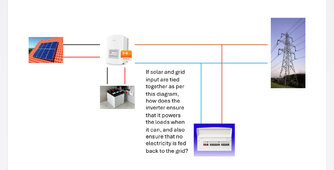william hamilton
New Member
Hi all, I am currently designing a solar system for my farm, aimed at reducing electricity bills.
I need the system to be connected to the grid, prioritising energy produced via solar, but using the grid otherwise. I do not want to export any energy to the grid.
I am trying to understand how I connect the inverter into the grid electricity supply, and most diagrams seem to show that is connected via a splice into the incoming grid connection line. As such I don’t understand two things.
1. How the solar generation is prioritised over the grid supply
2. How do I ensure 0 export, ensuring that all generated electricity is used on-site.
Can anyone help?
Thanks,
William
I need the system to be connected to the grid, prioritising energy produced via solar, but using the grid otherwise. I do not want to export any energy to the grid.
I am trying to understand how I connect the inverter into the grid electricity supply, and most diagrams seem to show that is connected via a splice into the incoming grid connection line. As such I don’t understand two things.
1. How the solar generation is prioritised over the grid supply
2. How do I ensure 0 export, ensuring that all generated electricity is used on-site.
Can anyone help?
Thanks,
William




